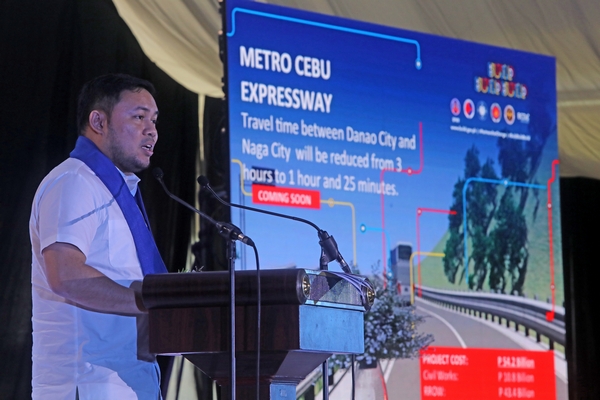
Public Works and Highways Secretary Mark Villar gives a primer on the Metro Cebu Expressway that will stretch from Naga City to Danao City during the Mandaue City Chamber of Commerce and Industry Business Summit in August last year. (CDN file photo)
(PART 1)
‘BUILD, BUILD, BUILD’
A metro expressway. Bridges to Bohol and Negros islands. New international port with bypass road.
Cebu’s landscape is expected to change in four years when the Duterte administration implements these major infrastructure projects under its ambitious “Build, Build, Build” program aimed at bringing down production cost, increase mobility of people and goods, spur countryside development, among others.
But these projects for Cebu under the program indicate how the administration gives importance to the island-province that gave Mr. Rodrigo Duterte two million votes in 2016 presidential polls.
Of the eight bridges, worth at least P269 billion, that will connect the Visayas to Luzon and Mindanao, two of these are in Cebu.
These are the the 5.5-km Cebu-Negros Link Bridge and the 24.5 km Cebu-Bohol Bridge.
The six others are the 18.2 km bridge that will connect Luzon to Samar; the 20-km bridge connecting Leyte to Surigao in Mindanao either through an underwater tunnel bridge or a long-span overhead bridge; the 5.7 km bridge connecting the islands of Panay and Guimaras; the 12.3-km bridge from Guimaras to Negros islands; a one kilometer Bohol-Lapinig Island Bridge;
Aside from the bridges, there are other massive projects worth at least P123.68 billion that are being undertaken by the administration for the Visayas.
Three of these are in Cebu: the world-class passenger terminal building at the Mactan Cebu International Airport in Lapu-Lapu City, Cebu which will open in June; the 73.75-km Metro Cebu Expressway that will connect Danao City in the north to Naga City in the south; and the the new Cebu International Container Port, a P9.2 billion project aims to add to the current Cebu International Port twenty-foot equivalent unit (TEU) container yard capacity.
The controversial Bus Rapid Transit is also included in the Build, Build, Build program.
While it has been approved by National Economic and Development Authority Investment Coordinating Committee (Neda-ICC), its implementation has been suspended pending in review by the Department of Transportation.
Two other projects under the Build, Build, Build are in the neighboring provinces of Bohol and Negros Oriental: The Bohol (Panglao) Airport worth P4.5 billion which will be operational by August and the establishment of a night rating at Dumaguete airport.
Also in the pipeline are the maintenance and development projects for the Bacolod and Iloilo airports that will start next year.
The Leyte Tide Embankment Project worth P7.9 billion covers a length of about 27.3 km from the shoreline of Barangay Diit of Tacloban City to Tanauan town both in Leyte to protect Leyte from another storm surge like what happened in 2013 when super typhoon “Yolanda” pummeled the province.
The other ongoing projects are the Bacolod Economic Highway, a 21.8 km, four-lane road with three bridges and a two-way bike lane that would serve an alternative circumferential road bypassing the busy Bacolod City Central District.
Part of the “Build, Build, Build” infrastructure program is the Central Spine Roro Alignment Project which seeks to align the road and sea linkages through the Roll on Roll off system from the Batangas Port down to Cagayan de Oro City.
The flagship projects of the administration were identified by the economic team who looked into the infrastructure projects needed and suited in the area, said Secretary Michael Dino, presidential assistant in the Visayas.
Dino said the Metro Cebu Expressway would start this year because P300 million of its P50-billion budget had already been released.
“We have the budget already so we have to spend that. We will start in the second quarter or third quarter the latest,” he said.
In 2019, he added, a budget of P1 billion would be released for the project.
Based on the Build, Build, Build website, (www.build.gov.ph), this project will have a two-km tunnel and is divided into three segments.
These are Talisay-Cebu City-Mandaue (Segment 1), Consolacion-Liloan-Compostela-Danao (Segment 2), and Naga-Minglanilla (Segment 3).
Project completion is set on Dec. 30, 2022, the year when President Duterte steps down from office.
Although the website said the budget was pegged at P18 billion, Dino explained that the allocation had gone up to P50 billion due to right-of-way acquisition.
To prevent the budget from ballooning further due to land speculation, Dino declined to give the specific areas where the expressway would pass.
But he assured that the construction of the expressway would not create a bottleneck – a usual consequence in road projects — since it would be built outside Metro Cebu center.
The six-lane expressway will be built outside the human settlement – which means new roads will be opened in order to decongest traffic especially in the cities of Talisay, Cebu and Mandaue.
Since it will be an expressway similar to the South Luzon Expressway and North Expressway at the National Capital Region, travel from Cebu north to the south will be faster.
If one travels at 70 km per hour, it is assumed that one will reach Naga City from Danao City in an hour, almost four times faster than the usual route.
If there will be traffic, it will be at the entry and exit points but Dino assured that it will be minimal.
Gordon Alan “Dondi” Joseph, Cebu Business Club president, said he liked the Metro Cebu Expressway project since it would address problem of mobility and allow quicker access between Cebu’s north and south.
“We need bypass roads to reduce the number of cars that travel through the cities,” he said.
He, however, suggested that the exits and entrance points must be planned properly to allow smooth traffic integration.
“These are design issues and scientific solutions exist. This is common in the developed areas of the world,” he stressed.
Another important project in Cebu is the Cebu International Container Port (CICP).
(To be continued)